南方医科大学学报 ›› 2025, Vol. 45 ›› Issue (5): 911-920.doi: 10.12122/j.issn.1673-4254.2025.05.03
张安邦1( ), 孙秀颀1, 庞博1, 吴远华1, 时靖宇1, 张宁2, 叶涛3(
), 孙秀颀1, 庞博1, 吴远华1, 时靖宇1, 张宁2, 叶涛3( )
)
收稿日期:2024-12-26
出版日期:2025-05-20
发布日期:2025-05-23
通讯作者:
叶涛
E-mail:544820318@qq.com;yetao008@gzy.edu.cn
作者简介:张安邦,博士,副主任医师,E-mail: 544820318@qq.com
基金资助:
Anbang ZHANG1( ), Xiuqi SUN1, Bo PANG1, Yuanhua WU1, Jingyu SHI1, Ning ZHANG2, Tao YE3(
), Xiuqi SUN1, Bo PANG1, Yuanhua WU1, Jingyu SHI1, Ning ZHANG2, Tao YE3( )
)
Received:2024-12-26
Online:2025-05-20
Published:2025-05-23
Contact:
Tao YE
E-mail:544820318@qq.com;yetao008@gzy.edu.cn
Supported by:摘要:
目的 探讨电针(EA)预处理通过调节肠道微生物群和Nrf2/HO-1信号通路以及抑制铁死亡来减轻脑缺血再灌注损伤(CIRI)的潜力。 方法 诱导CIRI的大鼠接受大脑中动脉堵塞(MCAO)手术,并分为假手术组、模型组和EA治疗组,10只/组。EA治疗在百会穴(DU20)和足三里穴(ST36)于MCAO前3 d进行。评估神经功能缺损和开放场行为,使用TTC、Nissl和HE染色检查脑梗死和海马病理。通过ELISA测定脑组织中丙二醛、活性氧和超氧化物歧化酶水平,利用qRT-PCR和Western blotting分析Bax、Bcl-2、Nrf2、HO-1、GPX4和SLC7A11的表达。免疫组化检测脑组织中GPX4、Nrf2和HO-1的水平,并收集粪便样本以分析肠道微生物群。 结果 EA预处理降低了大鼠的神经功能缺损评分(P<0.05),改善了自愿运动的频率和持续时间(均P<0.05)。TTC染色显示EA组的缺血性梗死面积小于模型组(P<0.05)。Nissl染色结果显示,模型组海马神经元数量减少且Nissl物质丢失,而EA组神经元存活率提高,Nissl物质含量恢复(P<0.05)。HE染色结果显示,模型组海马神经元排列不规则且病理变化明显,而EA组的结构和活力有所改善(P<0.05)。ELISA检测显示,模型组的丙二醛和活性氧水平升高,超氧化物歧化酶水平下降(均P<0.05);EA组则相反。EA治疗降低了Bax蛋白表达,增加了Bcl-2蛋白表达(均P<0.05),同时上调了铁死亡关键调控蛋白GPX4和SLC7A11的表达,免疫组化结果一致。EA上调Nrf2(P<0.05)和HO-1(P<0.05)的表达,激活Nrf2/HO-1信号通路,并改善肠道微生物群。 结论 电针预处理通过调节肠脑轴、激活Nrf2/HO-1信号通路、抑制细胞凋亡和铁死亡,有效缓解了大鼠脑缺血再灌注损伤,为其在缺血性脑血管疾病中的临床应用提供了科学依据。
张安邦, 孙秀颀, 庞博, 吴远华, 时靖宇, 张宁, 叶涛. 电针预处理通过调节肠道-大脑轴及Nrf2/HO-1信号通路抑制铁死亡减轻大鼠脑缺血再灌注损伤[J]. 南方医科大学学报, 2025, 45(5): 911-920.
Anbang ZHANG, Xiuqi SUN, Bo PANG, Yuanhua WU, Jingyu SHI, Ning ZHANG, Tao YE. Electroacupuncture pretreatment alleviates cerebral ischemia-reperfusion injury in rats by inhibiting ferroptosis through the gut-brain axis and the Nrf2/HO-1 signaling pathway[J]. Journal of Southern Medical University, 2025, 45(5): 911-920.
| Target gene | Forward primer | Reverse primer |
|---|---|---|
| Nrf2 | CTTCTGGGGATACAGTACAGCC | CTCCTTGGACATCATTTCATTG |
| HO-1 | AGGTCCTGAAGAAGATTGCG | GGCGAAGAAACTCTGTCTGTGA |
| Bax | GCGATGAACTGGACAACAAC | GCAAAGTAGAAAAGGGCAACC |
| Bcl-2 | GCGTCAACAGGGAGATGTCA | TTCCACAAAGGCATCCCAGC |
| β-actin | GCCATGTACGTAGCCATCCA | GAACCGCTCATTGCCGATAG |
表1 目标基因的引物序列
Tab.1 PCR primers for target genes
| Target gene | Forward primer | Reverse primer |
|---|---|---|
| Nrf2 | CTTCTGGGGATACAGTACAGCC | CTCCTTGGACATCATTTCATTG |
| HO-1 | AGGTCCTGAAGAAGATTGCG | GGCGAAGAAACTCTGTCTGTGA |
| Bax | GCGATGAACTGGACAACAAC | GCAAAGTAGAAAAGGGCAACC |
| Bcl-2 | GCGTCAACAGGGAGATGTCA | TTCCACAAAGGCATCCCAGC |
| β-actin | GCCATGTACGTAGCCATCCA | GAACCGCTCATTGCCGATAG |
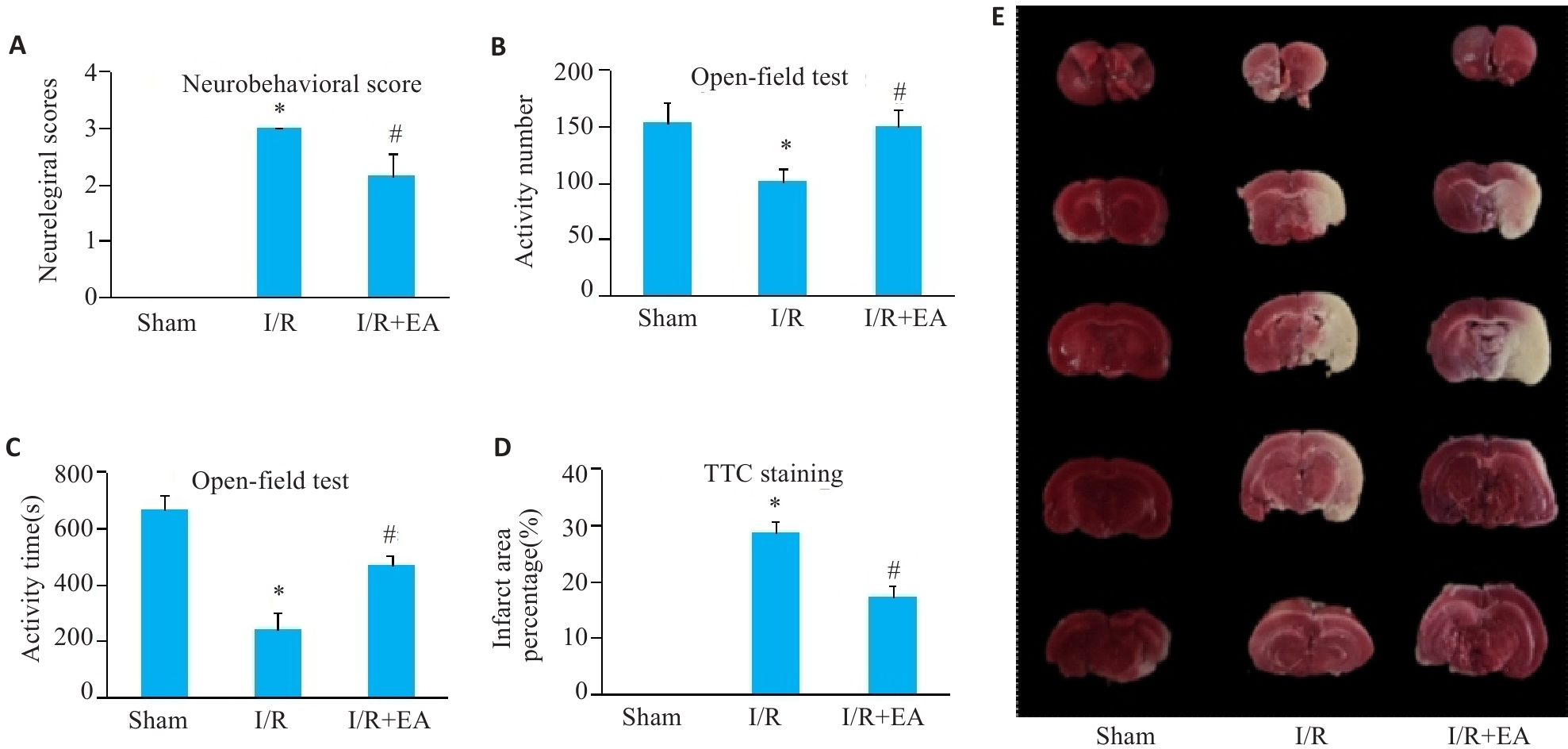
图1 EA对神经功能缺损评分和梗死面积的影响
Fig.1 Effect of electroacupuncture (EA) preconditioning on neurological deficit scores and cerebral infarct volume in rats with cerebral ischemia-reperfusion injury (CIRI). A: Neurological deficit scores of the rats. B: Locomotor activity counts of the rats. C: Locomotor activity duration. D, E: TTC staining for determining cerebral infarct volume percentage in the rats. Data are presented as Mean±SE (n=10). *P<0.05 vs sham group; #P<0.05 vs I/R group.
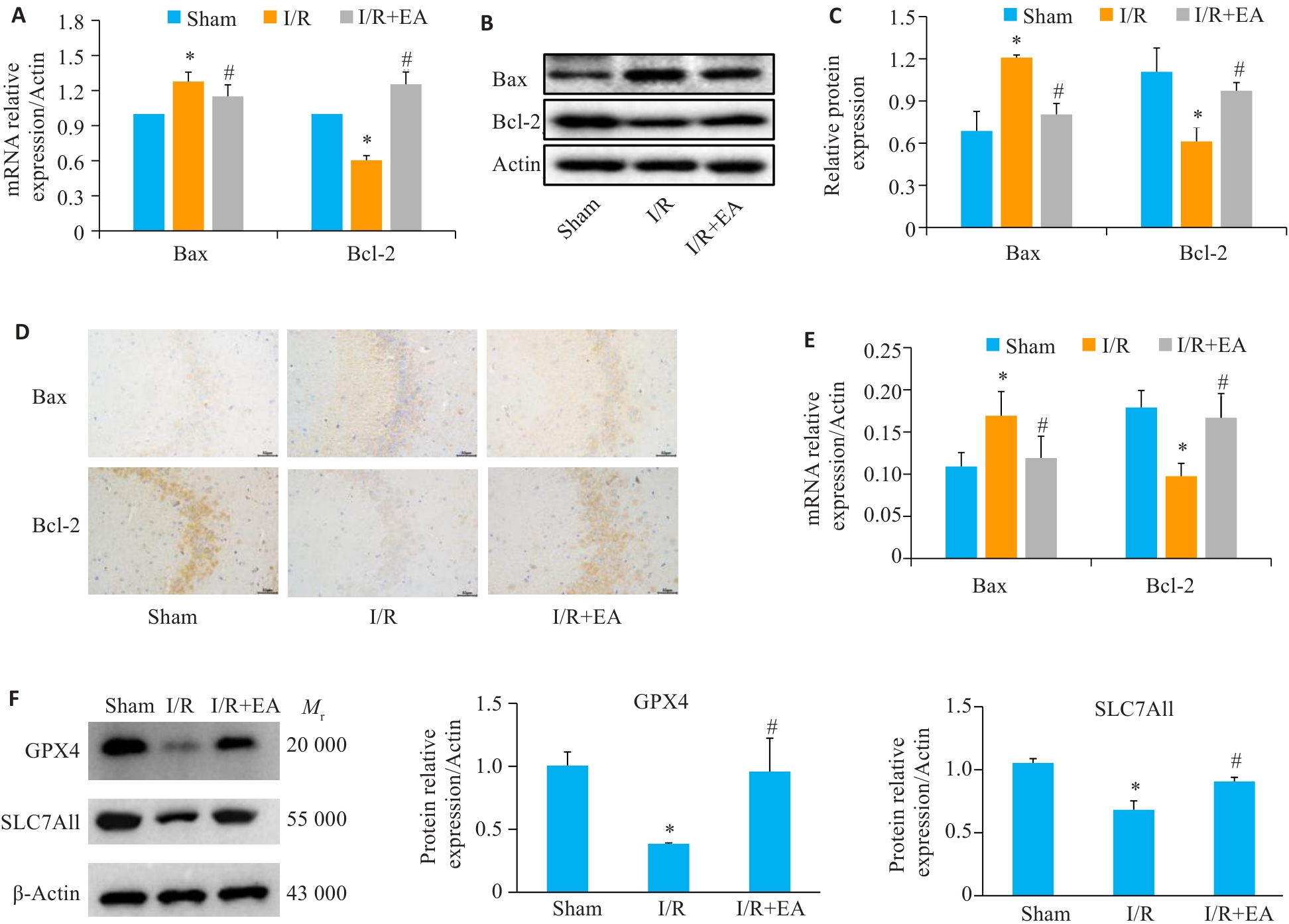
图4 Western blotting检测脑组织中Bax和Bcl-2蛋白的表达
Fig.4 Protein expressions of Bax, Bcl-2, GPX4 and SLC7A11 in rat brain tissue. A-C: Western blotting for Bax and Bcl-2 protein expressions in the brain tissue. D, E: Immunofluorescence staining of Bax and Bcl-2 expression in the brain tissue (×400). F: Western blotting of GPX4 and SLC7A11 protein expressions in the brain tissue. Data are presented as Mean±SE (n=10). *P<0.05 vs sham group; #P<0.05 vs I/R group.
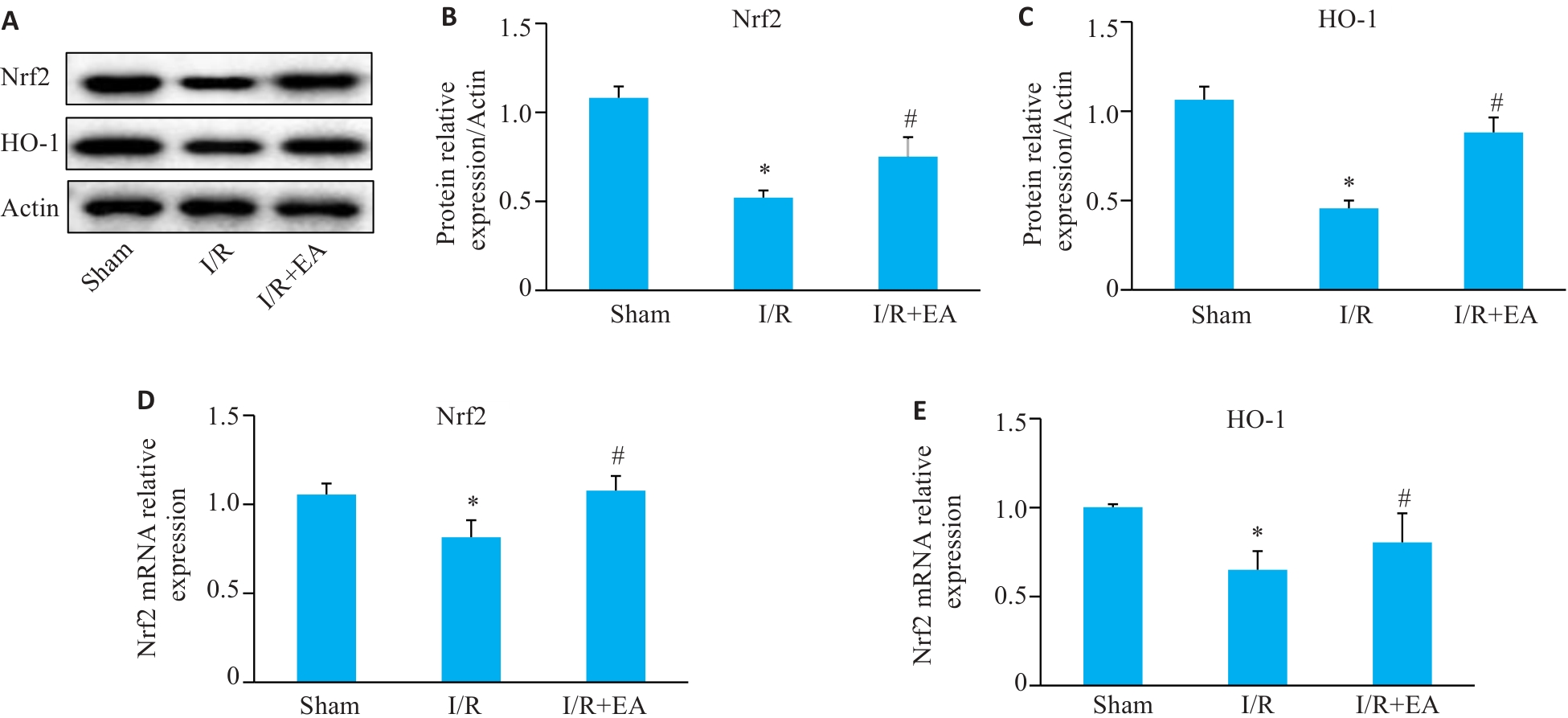
图5 Nrf2和HO-1在脑组织中的相对表达
Fig.5 Relative protein and mRNA expressions of Nrf2 and HO-1 in rat brain tissues. A-C: Western blotting for Nrf2 and HO-1 protein expressions. D, E: mRNA expression levels of Nrf2 and HO-1. Data are presented as Mean±SE (n=10). *P<0.05 vs sham group; #P<0.05 vs I/R group.
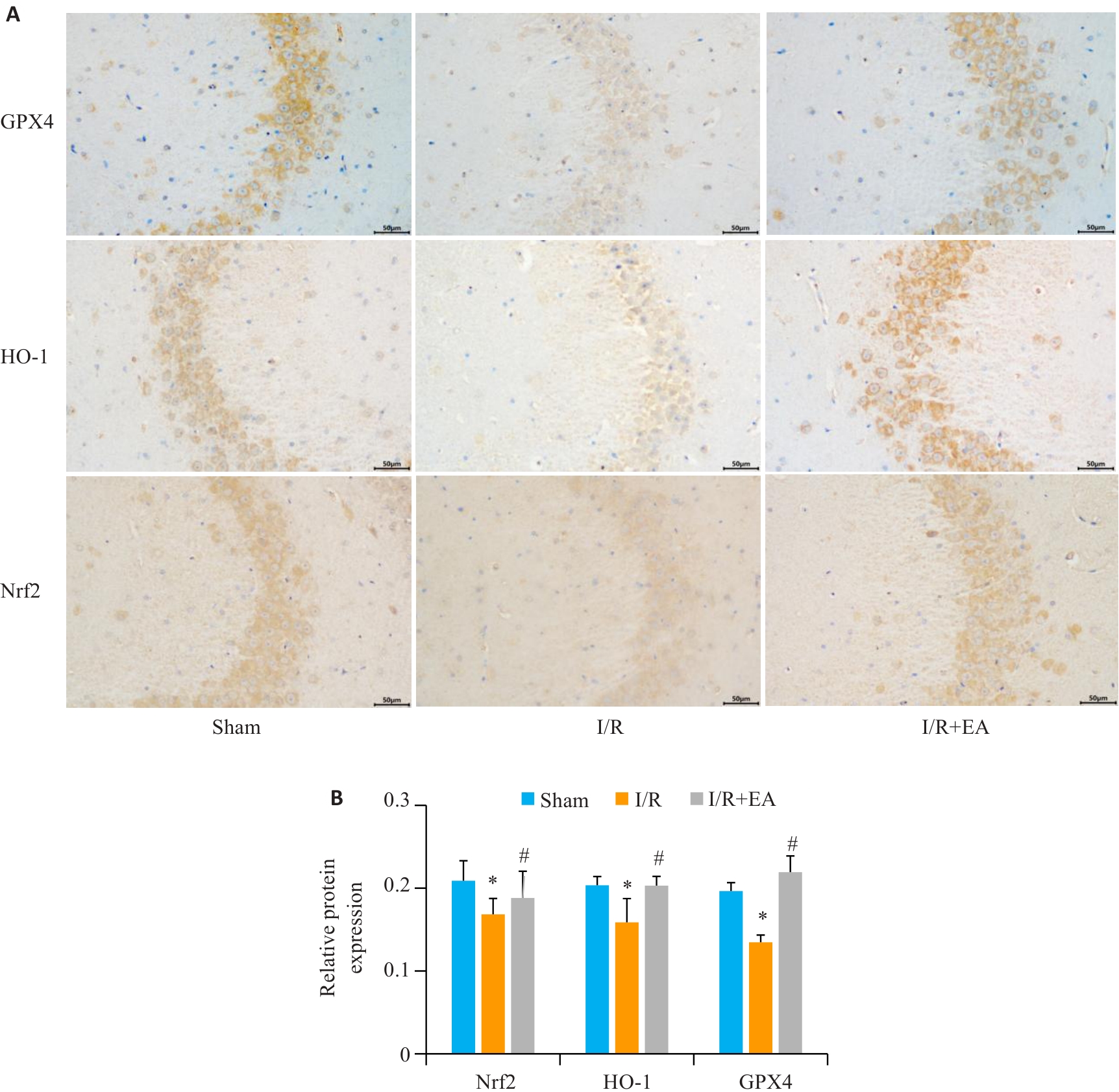
图6 各组中Nrf2、HO-1、GPX4的表达水平
Fig.6 Expression levels of Nrf2, HO-1 and GPX4 in each group. A, B: Immunofluorescence staining of Nrf2, HO-1 and GPX4 expression in rat brain tissue (×50). *P<0.05 vs sham group; #P<0.05 vs I/R group.
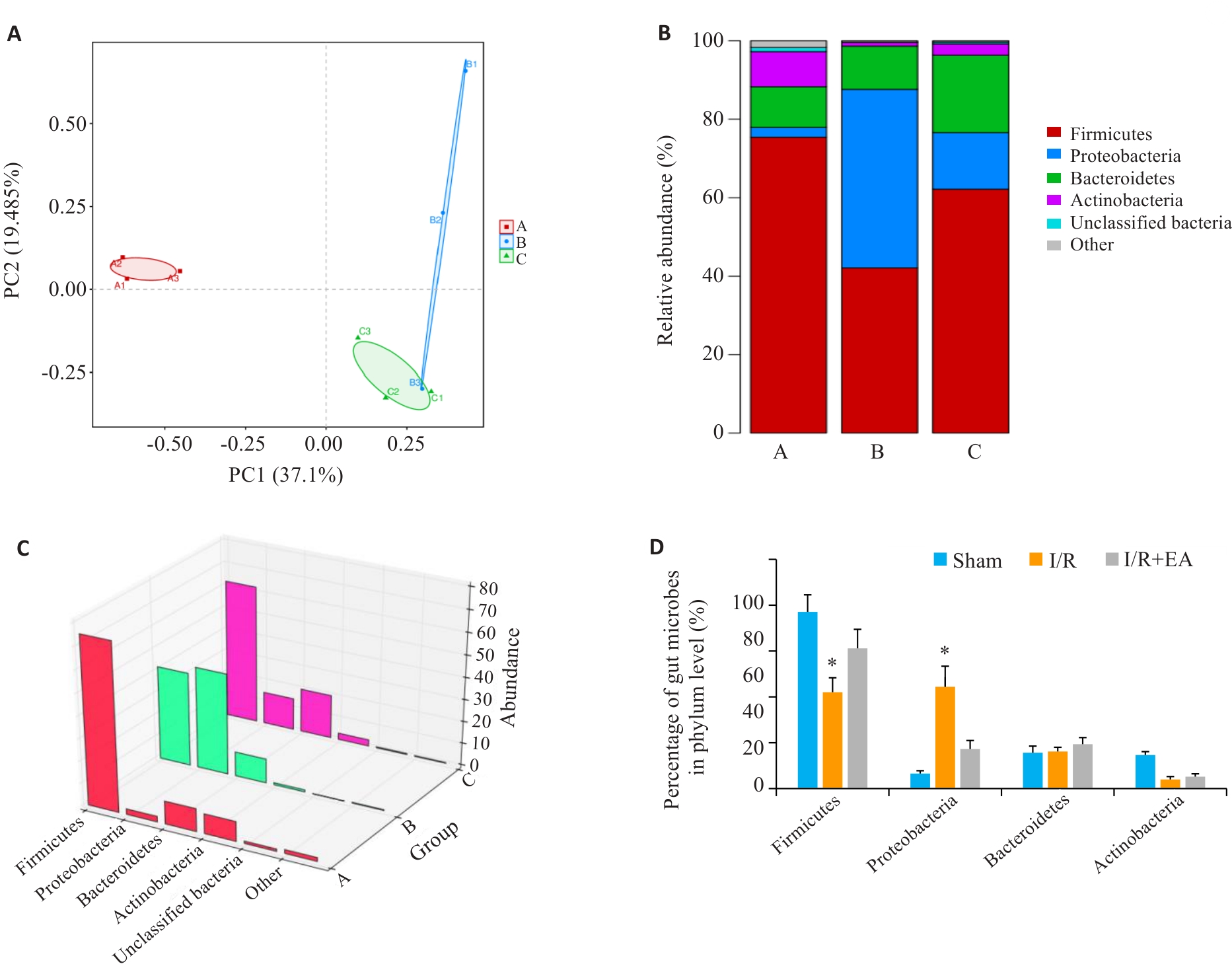
图7 电针预处理改善脑缺血再灌注大鼠肠道微生物群
Fig.7 EA pretreatment improves gut microbiota in rats with cerebral ischemia-reperfusion injury. A: Principal component analysis (PCA) of OTU level. B: Relative abundance of gut microbiota. C: Heatmap of gut microbiota abundance. D: Percentage composition of gut microbiota (%). *P<0.05 vs sham group.
| 1 | Hu XM, Michael De Silva T, Chen J, et al. Cerebral vascular disease and neurovascular injury in ischemic stroke[J]. Circ Res, 2017, 120(3): 449-71. |
| 2 | Alonso de Leciñana M, Egido JA, Casado I, et al. Guidelines for the treatment of acute ischaemic stroke[J]. Neurologia, 2014, 29(2): 102-22. |
| 3 | Virani SS, Alonso A, Benjamin EJ, et al. Heart disease and stroke statistics-2020 update: a report from the American heart association[J]. Circulation, 2020, 141(9): e139-596. |
| 4 | Herpich F, Rincon F. Management of acute ischemic stroke[J]. Crit Care Med, 2020, 48(11): 1654-63. |
| 5 | Zhang Y, Geng JL, Hong Y, et al. Orally administered crocin protects against cerebral ischemia/reperfusion injury through the metabolic transformation of crocetin by gut microbiota[J]. Front Pharmacol, 2019, 10: 440. |
| 6 | Liu JF, Zhang TH, Wang YY, et al. Baicalin ameliorates neuropathology in repeated cerebral ischemia-reperfusion injury model mice by remodeling the gut microbiota[J]. Aging, 2020, 12(4): 3791-806. |
| 7 | Sun J, Wang FY, Ling ZX, et al. Clostridium butyricum attenuates cerebral ischemia/reperfusion injury in diabetic mice via modulation of gut microbiota[J]. Brain Res, 2016, 1642: 180-8. |
| 8 | 金深辉, 张明晓, 梁冬冬, 等. 电针治疗对脑缺血患者的临床分析[J]. 中国现代医生, 2017, 55(23): 73-6. |
| 9 | Han JQ, Liu CL, Wang ZY, et al. Anti-inflammatory properties of lipoxin A4 protect against diabetes mellitus complicated by focal cerebral ischemia/reperfusion injury[J]. Neural Regen Res, 2016, 11(4): 636-40. |
| 10 | 针刺通过调节肠道微生物和抑制炎症因子释放发挥对帕金森病运动功能的改善效应[J]. J Acupunct Tuina Sci, 2022, 20(5): 339-53. |
| 11 | 周 伟, 汪昌参, 张 辽, 等. 电针通过恢复肠道微生物群和抑制LPS-TLR4-NF-κB轴减轻大鼠实验性类风湿性关节炎[J]. 长春中医药大学学报, 2024, 40(5): 517-22. |
| 12 | Zhu Y, Xiong Y, Gu Y, et al. Chiropractic therapy modulated gut microbiota and attenuated allergic airway inflammation in an immature rat model[J]. Med Sci Monit, 2020, 26: e926039. |
| 13 | Hong JJ, Chen J, Kan JM, et al. Effects of acupuncture treatment in reducing sleep disorder and gut microbiota alterations in PCPA-induced insomnia mice[J]. Evid Based Complement Alternat Med, 2020, 2020: 3626120. |
| 14 | Chang QY, Lin YW, Hsieh CL. Acupuncture and neuroregeneration in ischemic stroke[J]. Neural Regen Res, 2018, 13(4): 573-83. |
| 15 | Zhang QQ, Deng PY, Chen SH, et al. Electroacupuncture and human iPSC-derived small extracellular vesicles regulate the gut microbiota in ischemic stroke via the brain-gut axis[J]. Front Immunol, 2023, 14: 1107559. |
| 16 | Yang XC, Jin YJ, Ning R, et al. Electroacupuncture attenuates ferroptosis by promoting Nrf2 nuclear translocation and activating Nrf2/SLC7A11/GPX4 pathway in ischemic stroke[J]. Chin Med, 2025, 20(1): 4. |
| 17 | 陈思佳, 张安琪, 戴勤学, 等. YAP在电针预处理改善大鼠脑缺血再灌注损伤中的作用研究[J]. 中国针灸, 2021, 41(6): 651-6. DOI: 10.13703/j.0255-2930.20201108-k0003 |
| 18 | Ando M, Nagata K, Takeshita R, et al. The gut lactic acid bacteria metabolite, 10-oxo- cis-6, trans-11-octadecadienoic acid, suppresses inflammatory bowel disease in mice by modulating the NRF2 pathway and GPCR-signaling[J]. Front Immunol, 2024, 15: 1374425. |
| 19 | 罗 佳, 吴 宇, 刘京东, 等. 香叶醇通过调控Nrf2/HO-1途径调节氧化应激减轻大鼠脑缺血/再灌注损伤[J]. 中国药理学通报, 2024, 40(3): 431-9. DOI: 10.12360/CPB202310025 |
| 20 | Lan XB, Wang Q, Liu Y, et al. Isoliquiritigenin alleviates cerebral ischemia-reperfusion injury by reducing oxidative stress and ameliorating mitochondrial dysfunction via activating the Nrf2 pathway[J]. Redox Biol, 2024, 77: 103406. |
| 21 | 杨静静, 可海霞, 张海柱, 等. 桃叶珊瑚苷通过Nrf2介导的抗氧化应激减轻阿霉素诱导的心肌损伤[J]. 中国循证心血管医学杂志, 2024, 16(2): 173-6, 179. |
| 22 | 王 琪, 倪清蓉, 姜兆婷, 等. 抗氧化因子Nrf2对H2O2诱导的人黑素细胞氧化应激水平和抗氧化基因表达的影响[J]. 中国皮肤性病学杂志, 2022, 36(7): 744-50. |
| 23 | Huang MN, Yan Y, Deng ZH, et al. Saikosaponin A and D attenuate skeletal muscle atrophy in chronic kidney disease by reducing oxidative stress through activation of PI3K/AKT/Nrf2 pathway[J]. Phytomedicine, 2023, 114: 154766. |
| 24 | Luo MW, Bao L, Xue YY, et al. ZMYND8 protects breast cancer stem cells against oxidative stress and ferroptosis through activation of NRF2[J]. J Clin Invest, 2024, 134(6): e171166. |
| 25 | Wei C, Chen XL, Chen DW, et al. Dihydromyricetin enhances intestinal antioxidant capacity of growing-finishing pigs by activating ERK/Nrf2/HO-1 signaling pathway[J]. Antioxidants, 2022, 11(4): 704. |
| 26 | Zhang H, Hui XR, Wang YL, et al. Angong Niuhuang Pill ameliorates cerebral ischemia/reperfusion injury in mice partly by restoring gut microbiota dysbiosis[J]. Front Pharmacol, 2022, 13: 1001422. |
| 27 | Kishimoto M, Suenaga J, Takase H, et al. Oxidative stress-responsive apoptosis inducing protein (ORAIP) plays a critical role in cerebral ischemia/reperfusion injury[J]. Sci Rep, 2019, 9(1): 13512. |
| 28 | 谢 明, 钟 朕, 欧阳训彦, 等. 川芎嗪防治大鼠脑缺血/再灌注损伤后炎症反应与细胞凋亡的作用[J]. 解剖学报, 2021, 52(6): 845-54. DOI: 10.16098/j.issn.0529-1356.2021.06.002 |
| 29 | 王 琼, 李 佳, 许辛寅, 等. 针刺对急性脑缺血大鼠昼夜节律蛋白Clock和Bmal1的影响[J]. 中华物理医学与康复杂志, 2020, 42(9): 839-42. DOI: 10.3760/cma.j.issn.0254-1424.2020.09.017 |
| 30 | Su F, Yang HJ, Guo AC, et al. Mitochondrial BKCa mediates the protective effect of low-dose ethanol preconditioning on oxygen-glucose deprivation and reperfusion-induced neuronal apoptosis[J]. Front Physiol, 2021, 12: 719753. |
| 31 | Xiong F, Wei WP, Liu YB, et al. Long noncoding RNA XIST enhances cerebral ischemia-reperfusion injury by regulating miR-486-5p and GAB2[J]. Eur Rev Med Pharmacol Sci, 2021, 25(4): 2013-20. |
| 32 | Lv Q, Niu HY, Yue LZ, et al. Abnormal ferroptosis in myelodysplastic syndrome[J]. Front Oncol, 2020, 10: 1656. |
| 33 | Li YZ, Zhu HC, Du Y, et al. Silencing lncRNA SLC16A1-AS1 induced ferroptosis in renal cell carcinoma through miR-143-3p/SLC7A11 signaling[J]. Technol Cancer Res Treat, 2022, 21: 15330338221077803. |
| 34 | Wang N, Nie H, Zhang YY, et al. Dexmedetomidine exerts cerebral protective effects against cerebral ischemic injury by promoting the polarization of M2 microglia via the Nrf2/HO-1/NLRP3 pathway[J]. Inflamm Res, 2022, 71(1): 93-106. |
| 35 | Winek K, Meisel A, Dirnagl U. Gut microbiota impact on stroke outcome: Fad or fact[J]? J Cereb Blood Flow Metab, 2016, 36(5): 891-8. |
| 36 | Benakis C, Brea D, Caballero S, et al. Commensal microbiota affects ischemic stroke outcome by regulating intestinal γδ T cells[J]. Nat Med, 2016, 22(5): 516-23. |
| 37 | Winek K, Dirnagl U, Meisel A. The gut microbiome as therapeutic target in central nervous system diseases: implications for stroke[J]. Neurotherapeutics, 2016, 13(4): 762-74. |
| 38 | Houlden A, Goldrick M, Brough D, et al. Brain injury induces specific changes in the caecal microbiota of mice via altered autonomic activity and mucoprotein production[J]. Brain Behav Immun, 2016, 57: 10-20. |
| 39 | Wu WF, Sun YH, Luo N, et al. Integrated 16S rRNA gene sequencing and LC-MS analysis revealed the interplay between gut microbiota and plasma metabolites in rats with ischemic stroke[J]. J Mol Neurosci, 2021, 71(10): 2095-106. |
| [1] | 陈鑫源, 吴成挺, 李瑞迪, 潘雪芹, 张耀丹, 陶俊宇, 林才志. 双术汤通过P53/SLC7A11/GPX4通路诱导胃癌细胞铁死亡[J]. 南方医科大学学报, 2025, 45(7): 1363-1371. |
| [2] | 王静娴, 任自敬, 周佩洋. S1PR5激动与过表达通过调控氧化应激增强脑微血管内皮细胞屏障功能抵抗氧糖剥夺/复氧复糖损伤[J]. 南方医科大学学报, 2025, 45(7): 1451-1459. |
| [3] | 张梦影, 赵晨玲, 田丽伟, 余郭芳, 杨文明, 董婷. 肝豆扶木汤通过GPX4/ACSL4/ALOX15通路抑制铁死亡改善Wilson病小鼠的肝脏脂肪变性[J]. 南方医科大学学报, 2025, 45(7): 1471-1478. |
| [4] | 祝越轩, 诸章睿, 吴芃. 多硫酸戊聚糖缓解环磷酰胺诱导的小鼠间质性膀胱炎/膀胱疼痛综合征的机制:基于调节肠道微生物群和胆汁酸代谢[J]. 南方医科大学学报, 2025, 45(6): 1270-1279. |
| [5] | 浦延鹏, 王震, 储浩然. 眼针疗法通过上调METTL3介导的m6A甲基化修饰促进脑皮层血管新生进而改善脑缺血再灌注损伤大鼠的神经功能[J]. 南方医科大学学报, 2025, 45(5): 921-928. |
| [6] | 张林落, 李长青, 皇玲玲, 周学平, 娄媛媛. 梓醇扶正制毒配伍从SLC7A11/GPX4通路抑制铁死亡减轻雷公藤甲素肝毒性[J]. 南方医科大学学报, 2025, 45(4): 810-818. |
| [7] | 高志, 吴傲, 胡仲翔, 孙培养. 类风湿性关节炎中氧化应激与免疫浸润的生物信息学分析[J]. 南方医科大学学报, 2025, 45(4): 862-870. |
| [8] | 黄鹏伟, 陈洁, 邹金虎, 高雪锋, 曹虹. 槲皮素促进应激颗粒G3BP1解聚改善HIV-1 gp120诱导的星形胶质细胞神经毒性[J]. 南方医科大学学报, 2025, 45(2): 304-312. |
| [9] | 季春斐, 左宗超, 王钧, 李妙男. N-乙酰神经氨酸中通过抑制Nrf2轴促进缺氧/复氧损伤的H9C2心肌细胞发生铁死亡[J]. 南方医科大学学报, 2025, 45(1): 72-79. |
| [10] | 陈凯, 孟兆菲, 闵静婷, 王佳慧, 李正红, 高琴, 胡俊锋. 姜黄素通过抑制TXNIP/TRX-1/GPX4通路介导的铁死亡减轻脓毒症小鼠肺损伤[J]. 南方医科大学学报, 2024, 44(9): 1805-1813. |
| [11] | 欧阳明子, 崔佳琦, 王慧, 梁正, 皮大锦, 陈利国, 陈前军, 吴迎朝. 开心散通过减轻前额叶皮质铁死亡缓解小鼠的阿霉素化疗性抑郁[J]. 南方医科大学学报, 2024, 44(8): 1441-1449. |
| [12] | 张银亮, 骆泽谭, 赵睿, 赵娜, 徐志东, 奥迪, 丛古一, 刘新宇, 郑海伦. 血根碱通过调控STUB1/GPX4诱导直肠癌细胞发生铁死亡[J]. 南方医科大学学报, 2024, 44(8): 1537-1544. |
| [13] | 张钰明, 夏士程, 张淋淋, 陈梦茜, 刘晓婧, 高琴, 叶红伟. 金银花提取物对小鼠阿霉素肝脏损伤的保护作用[J]. 南方医科大学学报, 2024, 44(8): 1571-1581. |
| [14] | 曾静, 陈荣, 任香怡, 花雷, 阳勇, 魏江平, 张小梅. 异功散通过调控肠道微生物改善痴呆症模型大鼠的认知下降[J]. 南方医科大学学报, 2024, 44(7): 1297-1305. |
| [15] | 王元国, 张鹏. 铁死亡抑制基因在食管癌中的高表达分析[J]. 南方医科大学学报, 2024, 44(7): 1389-1396. |
| 阅读次数 | ||||||
|
全文 |
|
|||||
|
摘要 |
|
|||||